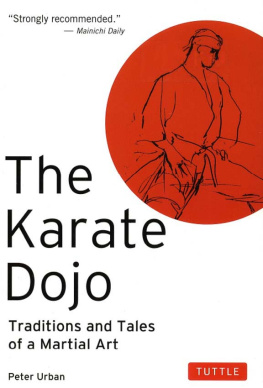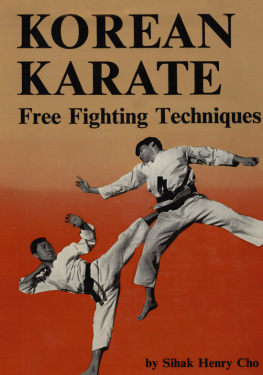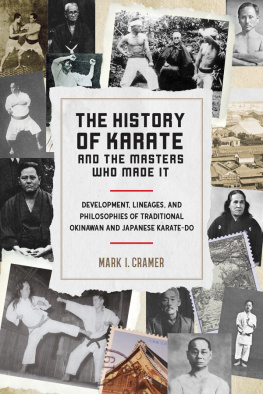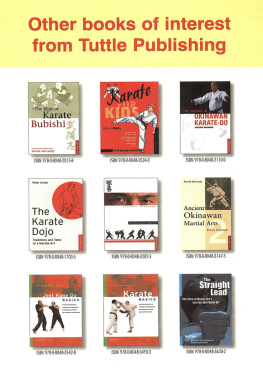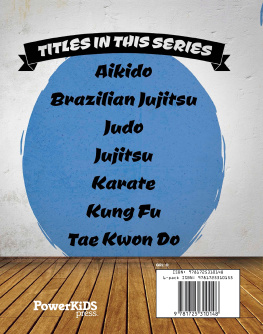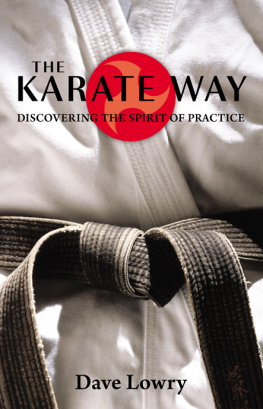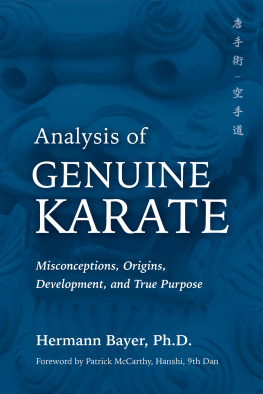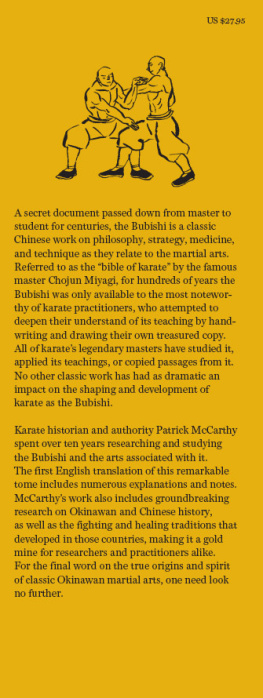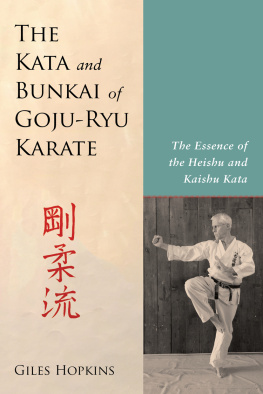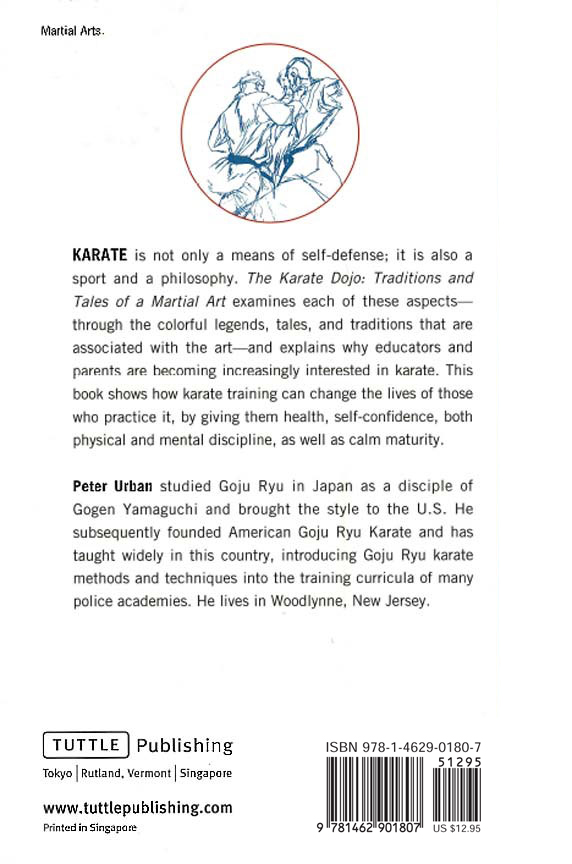The author wishes to express his deepest appreciation to Roy Colonna of New York City for his Karate drawings, and to James Brown and Joan R. Brochstein of Tokyo for their patience and immeasurable assistance in bringing the original manuscript to life.
The weaponless weapon
K arate is a martial art, a concept, a way of life new to the western world. Despite its grand and long-lived tradition in the Orient, Karate has until recently been unknown to most of the world's population; only in the past decade have Americans become aware of this fascinating art of self-defense. In the pages of this book, we shall discover why Karate is now flourishing throughout the world, why it has become a modus vivendi for millions of martial arts devotees.
Karate owes its profound impact on Americans to the promoters of the mass media, who realized the potential excitement such a sport could engender and who therefore gave it maximum exposure. By means of television, motion pictures, newspapers, and magazines, a new hero image has been implanted in the American mind. No longer is man's strength limited to the weapon he carries: he now possesses the "weaponless weapon," his own body, and all feats of prowess are possible. Americans are becoming conscious of the fact that their physical capabilities are dependent upon individual determination. The widespread publicity of Karate is responsible for the increasing numbers of people who have become confident in their ability to fight, to hold their own in a society of competition.
Perhaps the most significant result of the growing awareness of Karate is the realization among educators that here is an unexplored area of knowledge: there is much to be learned about Karate as a practical means of self-defense, as a sport, and as a philosophy. The American parent too has become aware of the necessity of equipping his children with a knowledge of the martial arts if they are to develop fullymentally as well as physically. The art of self-defense has been virtually ignored by families and by schools; these social institutions now believe that it must be included in a realistic approach to education. Karate teachers in particular have been appalled by society's lack of concern for the welfare of its youth.
One of the great problems facing American society today is lack of respect for authority; it has become common for teenagers to harrass policemen and teachers. It is apparent that such power figures are ill-equipped to defend themselves to their maximum capacity against those who would challenge them. Since a child's respect for an adult often has strength as its basis, it is essential that all adults who deal with children be physically competent. The youngster who is reared in an atmosphere of shootings and knifings would perhaps emerge from childhood as a better citizen if as a youth he felt respect for those in authority. In later years, the fact that his respect was originally based on the physical prowess of his elders would not be important; the fact would remain that he did respect them. The blackboard jungle that is all too common in American cities would cease to exist if teenagers knew that their teachers' knowledge encompassed more than history or mathematics, that they also had knowledge of the art of self-defense.

If Karate were to be made a natural part of one's education, much of the unhappiness and neurosis so prevalent today would disappear; crime would inevitably be reduced. The unspoken taboo against physically trained women would be lifted, and the defenseless women of today would be capable of defending themselves in any situation.
Americans who had served in the Far East during World War II and the Korean War introduced Karate to the United States. Despite the widespread opinion that Karate was merely a fad which would soon pass from the national scene, this unique sport captured lasting interest in America. Since World War II, thousands of Americans have adopted Karate wholeheartedly as a way of life, as a means of self-defense, or simply as a rewarding physical development program. The latter is especially true of businessmen and theatrical people, who depend so heavily upon health, appearance, and psychic confidence for competitive success.
Karate is filling two vital needs previously unrecognized in American society: the human needs to express emotion, and to live without fear. Americans, taught from childhood to suppress their feelings, often acquire psychological problems; through a martial art such as Karate, young people find an outlet for aggression and learn not to fear emotions.
Young men of draft age are now training in Karate by the thousands in order to be as well prepared as possible for the service. Such training can never be a mistake; the advantage of having the weaponless weapon speaks for itself in this instance. Countless college students are studying Karate, keenly aware of its usefulness throughout life. Having realized the value of the martial arts, increasing numbers of police academies are experimenting with its techniques; Karate training is now provided for many policemen in the large cities.
Physicians too have become well aware of the worth of Karate and are prescribing such a program as therapy for many of their patients. Over the years, it has been noted that those who practice Karate are rarely ill and are generally more vigorous than the average person. Not only does Karate training improve one's health physically, it also benefits one's mental attitude. New-found confidence is a prize which a Karateman acquires soon after the inception of his training. Physical strength attained in a short period of time has decided effects upon the individual. A most interesting observation is that in many cases individuals appear to have rapidly attained maturity through their study of Karate. Many parents have observed that Karate causes their young sons to become men very quickly: in some cases parental control can no longer be maintained by resorting to physical superiority.
Karate training is based on rigid discipline, a factor which limits the number of students who will ever achieve high proficiency. The rigorous training soon alienates certain types of people; those who dislike hard work, discipline, or competition soon lose interest. To excel in Karate is an achievement most valued by people who are highly realistic.
Karate tournaments are an ever-growing source of entertainment to sports fans of all types. When Karate becomes as popular as bowling or golf, the United States will have become a Karate-oriented nation. It will never replace boxing, wrestling, or other combative sports, but will instead enhance their appeal.
Karate societies and organizations, as well as societies dedicated to other martial arts, are springing up all over America, filling the social needs of individual and community alike. Despite its competitiveness, Karate training develops a feeling of brotherhood among its adherents; great rapport soon exists between brothers. Dojos are the freemason organizations of the martial arts; the training hall is a lodge, a home for the devotee. It opens many other worlds to students: the world of physical well-being, the world of social contacts, the world of self-confidence where fear has no place.
The most defamatory arguments leveled against Karate are made by critics who have unfortunately been exposed to inferior demonstrations or who were themselves unsuccessful in Karate training. It has been called savage, barbaric, uncivilized, phony. Karate devotees comfort themselves in the fact that all new knowledge goes through a period of doubt and ridicule before sufficient exposure causes the true picture to emerge.

